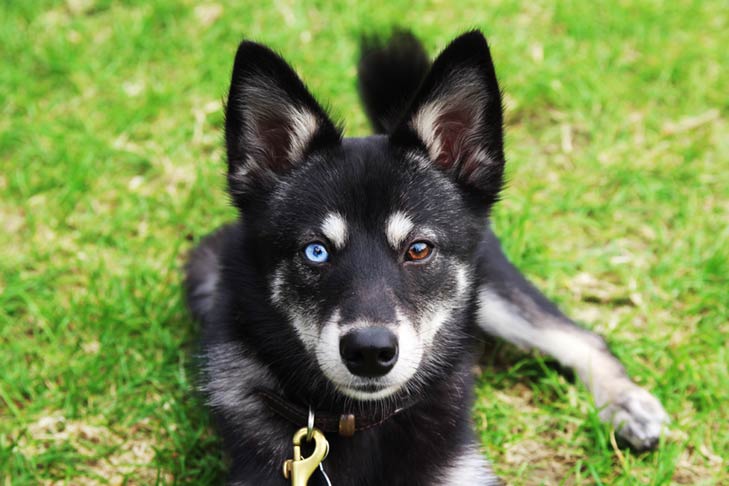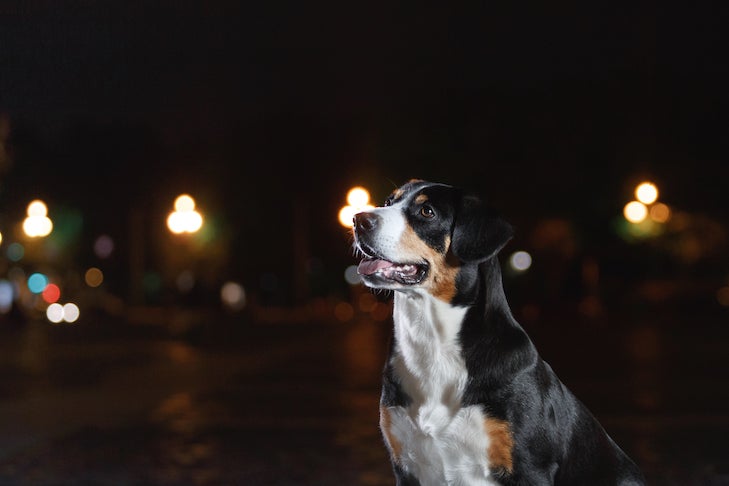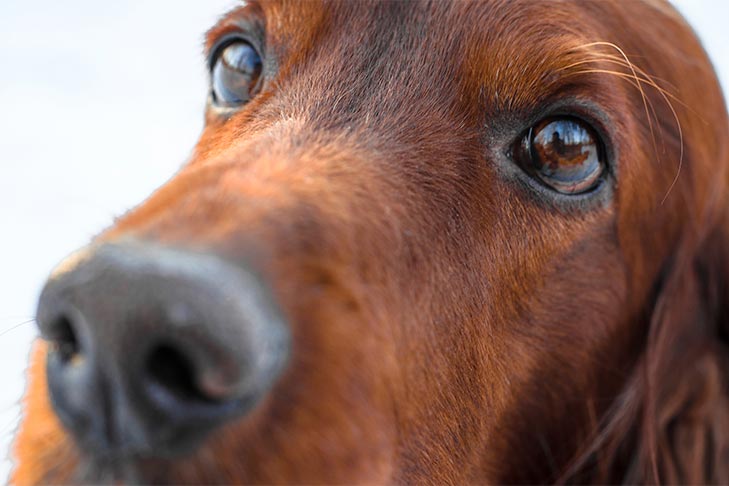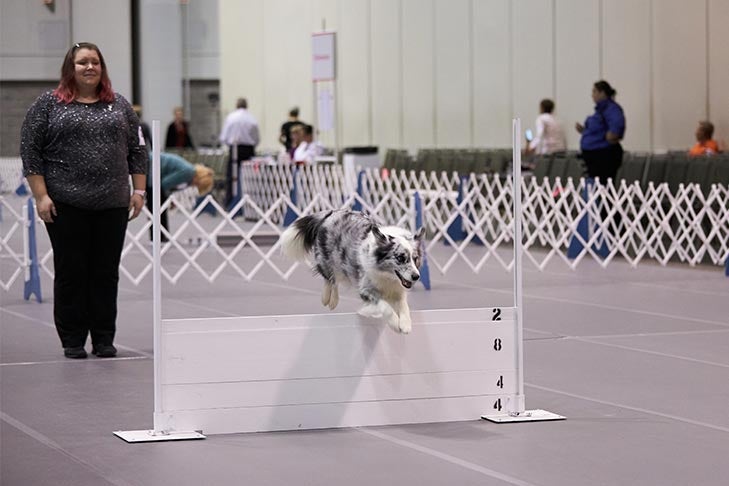
From going on adventures to your day-to-day activities, you and your dog share your lives together. But while you share so much of your world with them, you don’t share the same visual world. What you see, from colors to light, and what your dog sees, are actually very different. The eyes of each species evolved to maximize the type of vision they needed to survive. Many of these differences are obvious just by comparing dog versus human eyes. So what do dogs actually see, and how does their vision work?
The Eyes of Our Primate and Canine Ancestors
Humans evolved to have the best vision for the world in which our ancestors had to survive. Human beings are primates, and the primates we descended from did most of their foraging during daylight. They ate a varied diet, but a big part of it was thought to be fruits and berries. Since it was crucial for them to recognize when food was ripe versus green, color vision, especially red versus green color vision, was important. We’ve kept this trait even today, which allows us to see the full spectrum of the color wheel. Detail vision and depth perception, which aid in hand-eye coordination, were also essential to effectively pick berries and later, make tools.
On the other hand, dogs’ ancestors did most of their hunting in dim light, at night, dawn, or dusk. They were focused on hunting, so whether something was red or green made no difference to them. Their main focus was the small movements of prey, which their eyes are still adjusted to today.

Dog Eyes Versus Human Eyes
How Light Passes Through
To understand why dog and human eyes are different, you’ll first need to understand how the eye works. Light enters the eye through the clear cornea, the eye’s front surface. The larger the cornea, the more light can pass through it. If you look at a human’s cornea versus a dog’s, you can see that the human cornea is smaller. As a result, a human’s cornea cannot gather light as well as a dog’s can.
After the light passes through the cornea, it has to get past the iris, which is the colored layer of the eye. At the center of the iris is the pupil, which opens and closes to allow in more or less light. In the dark, the iris opens as wide as it can get. In the light, it clamps down to just a small diameter. If you sit in a dark room with your dog for about 10 minutes and then turn the light on quickly, or better yet, take a flash photo, you will see that your dog’s pupil can get much larger than yours can. So again, your dog’s eye is designed to allow more light to get in when it’s dark. There’s a trade-off, though—when the pupil is open wide, it’s like the aperture of a camera (the part of the lens through which light enters) being opened wide. It makes focusing on anything but a small range very difficult.
Different Cone Types in the Eyes
Behind the pupil is the lens, and larger lenses gather more light. Your dog has a larger lens than you do. The lens focuses the light on the retina, which is the layer of nerve cells near the back of the eye. Among the retinal cells are “photoreceptor” cells, which contain chemicals that react when light particles hit them, which helps form what we see.

There are two main kinds of photoreceptors: “rods” and “cones.” Rods contain a chemical that is extremely sensitive to all wavelengths of light. Rods are most important for vision in dim light, while cones are most important for vision in bright light and for color vision. Cones contain one of two or three different chemicals that are highly sensitive to only certain wavelengths of light. Dogs have many more rods than humans, but far fewer cones. Humans have three different cone types, each sensitive to different wavelengths, while dogs have only two cone types.
The rods and cones are connected to “ganglion cells,” which transmit information from the photoreceptors to the brain, which combines the impulses from the photoreceptors. In the periphery of the eye, as many as 1000 rods will be connected to one ganglion cell, further enabling tiny amounts of light to be detected—but at the expense of detail vision. Closer to the center of the eye, as few as five cones might be connected to one ganglion cell, enabling fine detail vision but at the expense of dim light vision. This is why you can better see dim stars in the periphery of your vision (when you’re using rods) than when you’re trying to look straight at a dim star (when you’re using cones).
Understanding a Dog’s Vision
Humans have so many cones in their retinas that they even have a small area right in the center that is made up of only cones. This area, called the “fovea,” has your sharpest vision. In fact, it’s the part you’re using to read these words. If you place one finger over this word HERE and try to read the surrounding words while still looking at your finger, you can get an idea of how it must be like for your dog, who doesn’t have a fovea, when they try to see fine details.
While dogs do have an area that is richer in ganglion cells, the shape of that area depends on the breed. A study found that dogs with long noses have a “visual streak,” which is a horizontal region of more ganglion cells across the midline of the retina.

In short-nosed dogs, scientists found a centrally-located round area of higher ganglion cell density. Dogs are the only species in which such a difference in ganglion cell density arrangement has ever been discovered, but it’s still nowhere near the human fovea.
There’s one more key difference between human and dog anatomy. If you shine a bright light into your dog’s eye at night, you’ll see that it glows back at you, usually with a greenish-colored “eye shine.” If you shine the same light into a person’s eye, all you will see is “red eye.” That’s because dogs have a reflective layer called the “tapetum lucidum” behind the retina that works like a mirror. Any light that gets past the retina without being absorbed by the rods or cones is reflected back through them again, where it has a second chance to be detected.
Some light still doesn’t get absorbed, so it’s reflected right back out through the pupils, which is the glow you see. People have only a layer of blood vessels, which is why you only see red from their eyes. Some dogs, especially blue-eyed dogs, may not have a tapetum. In some cases, dogs not having a tapetum is hereditary, while in others the reason is unknown.
Putting It Together
Dim Light Vision
Your dog’s eyes are specialized for vision in dim light. The dog’s cornea and pupil are larger, the lens is larger and rounder. The retina has more rods than cones, and more convergence onto ganglion cells, with a reflective layer for a second chance at detection.

We don’t know exactly how dim a light a dog can detect. But we do know that cats can see light that is about six times dimmer than the dimmest light that humans can see. Based on their eye anatomy, dogs shouldn’t be as good at seeing dim lights as cats are. When Pavlov tried to determine the lowest levels of light dogs could detect, he had to give up because it was so far below what any of the human scientists could measure. Unfortunately, this hasn’t been a topic of research since.
Focus
The lens ideally bends the light rays so that images come to a focus on the retina. Sometimes, the lens is too strong for the length of the eye and focuses the image in front of the retina, causing nearsightedness. In other cases, the lens is too weak for the length of the eye and focuses the image behind the retina, causing farsightedness.
Some breeds are more likely to be nearsighted than others. In a study of 1440 dogs of 90 breeds, some breeds like Rottweilers, Collies, Miniature Schnauzers, and Toy Poodles, tended to be nearsighted. Nearsightedness got worse with age in all breeds tested. Other breeds tended to be farsighted, including Australian Shepherds, Alaskan Malamutes, and Bouvier des Flandres.
Detail Vision
Almost every adaption that is good for dim light vision is bad for detail vision. The larger pupil makes the area of focus smaller, the rounder lens makes it difficult to adjust the focus, the larger convergence of photoreceptors onto fewer ganglion cells combines input over larger areas, and the reflected light from the tapetum scatters the image further.
In a 2017 study, researchers rewarded dogs for correctly identifying vertical or horizontal lines with decreasing amounts of space between them. In well-lit conditions, the dogs were able to see well from a distance, better than humans.

Color Vision
Not only does your dog have fewer cones than you do, but they also have fewer types of cones. Humans have three types of cones, each sensitive to different wavelengths of light corresponding to either blue, green, or red. But your dog has only blue and red cone types. Some people (mostly men) experience red-green colorblindness and also have only these two types of cones.
Dogs can see colors, but not the same colors as you see. They see greenish–blue colors as white or gray. They can tell the difference between blues and most other colors, including reds, but often confuse hues ranging between greenish-yellow and red. This means your dog may have a hard time spotting a red ball on a green lawn, or an orange retrieving dummy in a field of dead grass.
Dogs may see colors we can’t, due to the differences in their lenses. The lenses of mammals that have eyes specialized for seeing things at far distances have lenses that also filter out ultraviolet (UV) light. Other mammals, including dogs and cats, have lenses that transmit significant amounts of UV light. Even though there’s not a specific cone type that is maximally sensitive to UV light waves, all cone types still react to UV light waves.
Currently, there are no studies that can pinpoint whether dogs can actually see UV light. It’s a real possibility that they just may be more sensitive to blue, violet, and UV light than we thought.
Motion Vision
Dogs and humans are much more sensitive to moving objects than to ones standing still. Dogs are even more sensitive to moving objects because the rods in their eyes are built to catch motion. When comparing how fast dogs and humans can distinguish whether a light is flickering or steady, dogs can detect a light that flickers at 75 times per second, while humans can only detect flicker at 60 times per second. Because of this heightened sensitivity to flickering lights, dogs may view television screens, which are renewed at a rate of 60 times a second, as flickering motion rather than continuous motion.

Binocular Vision
The ganglion cells form the optic nerves, which travel to parts of the brain for processing. The optic nerves travels to both sides of the brain, which allows your brain to compare slight differences between how two eyes see the same object.
For example, hold your finger in front of you and close one eye and then the other. The nearer your finger is to your eyes, the more it seems to jump back and forth, because both eyes have a different view of it. Your brain compares the slight differences in the two views, and it uses this information to tell how far away your finger is.
Humans have very good depth perception because they have front-facing eyes. Both of your eyes see the same thing from slightly different angles, which is helpful for reaching and catching objects. Try catching a ball with one eye closed and see how much tougher it is!

Dogs use the same mechanism for depth perception, but because many dog’s eyes are more to the sides of their head, their good depth perception isn’t as good as yours. On the flip side, dogs have better vision to the sides, which makes it hard to sneak up on them. How much better? To get a rough idea, have a friend look straight ahead. Then, see how far to their side you can stand and still see the black pupil of their eye. Now try the same thing with your dog’s pupils to see the difference.
It’s hard to give an exact range of what around them dogs see because different dog breeds have different shaped heads and eyes that point more forward or more to the side at different degrees. Some estimates for “typical” dogs give a field for one eye of between 135 and 150 degrees, and for both eyes about 250 degrees. That makes the field of view for the average dog about 60 to 70 degrees greater than that of humans, but with less binocular overlap.
Supporting Your Dog’s Abilities
Your dog’s visual world is very different from yours. As we’ve evolved, we’ve made trade-offs in order to have the ideal vision for the worlds we inhabit.
Knowing what our dogs can see is extremely important. Some dog training and mentally-stimulating tasks deal with vision as the main sense, so knowing how your dog sees can help you.

If you’re training your dog, can they see the orange toy you’ve thrown in the green grass? A blue toy would be easier for them to spot. Should you trust your guard dog’s alert to something they see in the distance? Yes, especially at night. If you depend on a guide dog, it’s crucial to know what dangers they are aware of – they may not easily tell the difference between a red light and a green light, especially if the light is mounted sideways. Knowing what your dog can see can help you better understand them, throughout their lives and especially as they age.
This article is intended solely as general guidance, and does not constitute health or other professional advice. Individual situations and applicable laws vary by jurisdiction, and you are encouraged to obtain appropriate advice from qualified professionals in the applicable jurisdictions. We make no representations or warranties concerning any course of action taken by any person following or otherwise using the information offered or provided in this article, including any such information associated with and provided in connection with third-party products, and we will not be liable for any direct, indirect, consequential, special, exemplary or other damages that may result, including but not limited to economic loss, injury, illness or death.

